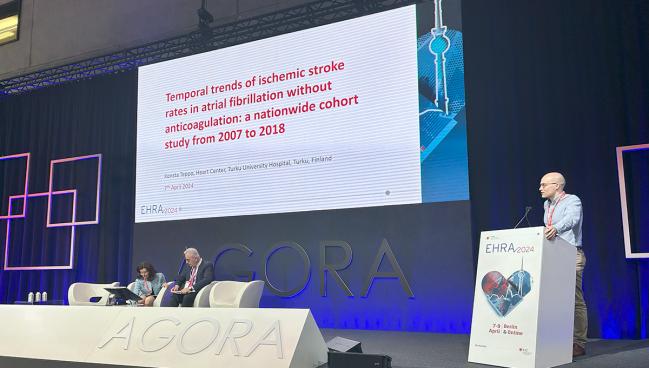Stroke Rates Fall Among AF Patients Not on Anticoagulation
Findings from a Finnish study don’t reveal a reason for the trend, but some speculate it could be due to better risk factor control.

BERLIN, Germany—The overall rate of ischemic stroke fell by about 25% over a recent 12- year period among patients newly diagnosed with atrial fibrillation (AF) who were not taking oral anticoagulation, a study out of Finland shows.
That trend, which was most pronounced in patients with a high estimated stroke risk at baseline and women older than 70, was seen despite overall increases in mean stroke risk scores and patient age over time, Konsta Teppo, MD (Turku University Hospital, Finland), reported during a Young Investigator Award competition session at the European Heart Rhythm Association Congress 2024.
Teppo said the study didn’t address why stroke rates declined over the years but noted that use of statins and medications to treat hypertension and diabetes has increased in this population. Comorbidity burden rose over time, “but maybe that just means we detect comorbidities and treat them better,” he said.
It’s possible, too, that the types of patients with newly diagnosed AF have changed with earlier diagnosis, he said. The implication is that catching patients earlier and treating risk factors could reduce stroke rates.
Teppo and his colleagues examined data from the Finnish Anticoagulation in Atrial Fibrillation (FinACAF) study, which covers all patients diagnosed with AF at any level of care in Finland. The analysis included 129,789 patients with new-onset AF diagnosed between 2007 and 2018 who were not taking oral anticoagulation. Follow-up included only time not on oral anticoagulation.
During the study period, mean patient age at baseline rose from 70.4 to 72.9 years and mean baseline CHA2DS2-VA score (CHA2DS2-VASc score minus the sex component) increased from 2.5 to 3.0.
Despite that, the overall ischemic stroke rate declined from 37 to 28 per 1,000 patient-years. The drop was greater in women (by 32%) than in men (by 7%), attenuating sex differences over time.
Greater declines were observed in patients with baseline CHA2DS2-VA scores of 5 or higher, with smaller changes seen in those with scores of 2 to 4 and no changes for those with scores of 0 or 1. Of note, for patients with a score of 1, the rate remained stable at 8.2 per 1,000 patient-years, which is just below the threshold (9.0 per 1,000 patient-years) above which the benefits of direct oral anticoagulant therapy are deemed to be worth the risk, Teppo said.
We’re doing a good job with stroke prevention. Jeff Healey
Speaking with TCTMD, Jeff Healey, MD (Population Health Research Institute, McMaster University, Hamilton, Canada), one of the judges of the Young Investigator Award competition, said a full manuscript would be needed to fully understand the study. But, he added, a strength of the analysis is that it’s from a single country, which helps control for differences in rates of stroke and comorbidities in different parts of the world when looking at trends over time.
A major question in his mind revolves around how AF was documented in the study. The population is aging and more AF would be expected, but the question is whether it’s being detected at an earlier stage with tools like rhythm monitoring and consumer wearables, Healey said. “It could be with the explosion of longer-term monitoring, availability of Holters and loops, that we’re just picking it up at an earlier stage, getting this lead time bias, and we’re just not seeing the events at this point,” he said.
Other possible explanations for the falling stroke rates, he said, could be improved treatment of conditions like hypertension and heart failure or changes in risk factors not captured by the CHA2DS2-VA score, like obesity and alcohol use.
It might be, Healey said, a combination of all those factors.
Whatever the reason, he said a major take-home message from the study is that “we’re doing a good job with stroke prevention” in patients with atrial fibrillation. “Twenty-five years ago,” he added, “we did nothing really effective to get rid of stroke. It was a leading cause of death. Now stroke in patients with atrial fibrillation causes fewer than 5% of the deaths. It’s really quite impressive how well we’ve moved the needle. We still have to deliver anticoagulation and address risk factors, but we’re clearly making a dent into stroke risk factors and into stroke outcomes.”
Still, the overall burden of risk factors is higher than ever, Healey said, “so there’s a public health message there in terms of societal-level programs, diet, exercise, and lifestyle choices.” And more data are needed on the impact of heart failure, which is now the leading cause of death in the AF population. “But we are moving the needle on stroke,” he said.
Todd Neale is the Associate News Editor for TCTMD and a Senior Medical Journalist. He got his start in journalism at …
Read Full BioSources
Teppo K. Temporal trends of ischemic stroke rates in atrial fibrillation without anticoagulation: a nationwide cohort study from 2007 to 2018. Presented at: EHRA 2024. April 7, 2024. Berlin, Germany.
Disclosures
- Teppo reports no relevant conflicts of interest.





Comments